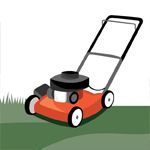Spring is that time when seasonal home maintenance can feel less like a chore and more like a second chance. Longer days filled with more sunlight can trigger the urge to deep clean. But spring is also a prime time to give a home its annual tune-up, seeking out vulnerabilities and taking care of anything that could cause problems – leaks, fires, breakdowns — as snow melts and spring rains and summer heat bear down.
With so many of us staying at home during the Covid-19 pandemic, noodling around the house can also provide a welcome break. Or an opportunity to tackle home projects that have been on a To Do list for too long.
Talk to a farmers agent about homeowners insurance.
Outdoor Spring Cleanup

The damage — or just the regular wear and tear — a house suffers from a long, cold winter may not be immediately obvious. Before starting outdoor maintenance, spend 20 to 30 minutes assessing the home's exterior, including the grounds and landscaping, furniture and features such as pools or grills, as well as the house itself.
Roof & Exterior
Do a ground-level inspection of the roof and home exterior to check for signs of winter weather damage. If you spot problem areas, you may need to schedule a professional inspection. (If you live in an area prone to high-wind disasters, read more about building and maintaining a strong, sturdy roof and what you need to know about roofing materials.)
Look for:
Loose or broken shingles
Cracks or signs of wear on the chimney
Damaged wood around windows and doors
Signs of animal/pest intrusions or nesting
Although a home exterior is designed to withstand exposure to the elements, periodic cleaning can improve the appearance and, in some cases, prolong the life of siding and other exterior details, according to the National Association of Home Builders (NAHB).
To wash: Cover shrubs and exposed lawn with plastic sheeting, then use a simple house cleaning kit that attaches to a garden hose to clean, then rinse, the exterior of the home, from the gutters to the ground.

A qualified roofer should inspect the roof of a home every three years. — National Association of Home Builders
Lawn Mower
Before firing up your mower for the first time this spring, inspect the blade. If it needs sharpening, have a professional sharpen it. Set the blade height at 1.5 inches to 2 inches for the first cutting. (Cutting more than one-third of the leaf blade when mowing can “shock” the lawn and cause browning.) After the first cut, set the blade height to 3 inches, which can help promote grass color and root growth.
Gutters
Carefully remove debris that can clog gutters. Water overflow from a clogged gutter can damage fascia boards and the foundation, as well as cause leaks across walls and ceilings.
Deck
Hammer or tighten nails or screws that have popped from deck boards. Look for loose or cracked boards and repair as needed. Wash wooden or composite decks with a cleaning solution designed for the material. (Find out what the pros say about building and maintaining a safe, sturdy deck.)
Pool
Inspect valves, filters and equipment for signs of wear or damage, and change or clean as needed. Or schedule an opening date with a pool service. (Read more about pool upkeep and other hidden costs.)

Maintaining a higher grass height can help reduce water usage by encouraging grass to produce more food for its roots through photosynthesis. When roots grow deeper into the soil, they can absorb more groundwater and nutrients. — Michigan State University Department of Crop and Soil Sciences
Indoor Spring Cleanup

Rooms
Spring is the time to clean the spots that are easily overlooked: baseboards, chair rails, moldings, ceiling fans, window blinds, and all the books in bookcases. Wash or dry clean drapes. Vacuum and spot treat upholstered furniture. Flip mattresses. Have carpets cleaned or rent a carpet cleaner. (If you live in an earthquake zone, consider small DIY earthquake safety projects that can help reduce damage inside your home. Or tackle one or two DIY projects that could reduce your next energy bill by 30 percent.)
Kitchen
Even with the best range hood, grease can build up on the tops (and fronts) of kitchen cabinets. Feel around for stickiness and use a good degreaser on the surfaces.
Freshen up the garbage disposal by grinding ice cubes (even better, lemon/vinegar ice cubes or rock salt and ice cubes), then flushing with hot water and baking soda. (Just don't fall for the myth that ice cubes will sharpen the disposal's cutting surfaces.)

Vacuum dust buildup from refrigerator coils to restore its efficiency. Clean seals and change the water filter.
Clean the range hood; clean filters (if you can, remove and run them through the dishwasher).
Attic
Attics need a post-winter once-over to check insulation for dampness (replace any that's wet) and seal cracks and leaks. Look for mold, insects or animals that may have crept in. Assess the area around vents to ensure nothing is blocking vents before summer heat builds.
Basement
Dampness loves a dark, underground space. Look for moisture and mold around the bottom of the foundation and seal any cracks. Check for excess humidity (consider a dehumidifier if needed). Open vents. Look for evidence of insect tunneling in any wooden framing.
Heating & Cooling
The heat has been running all winter and the air conditioner needs to be ready to go. Replace HVAC filters and check the drain pan to make sure it is draining and hoses are sound and connected. (Or schedule a biannual checkup/servicing.) If you use window air conditioners, it's time to install them.
Plumbing
The most common type of water damage to homes isn't caused by hurricanes or floods. It's caused by the dishwasher, hot water heater and other appliances or plumbing. Spring is a good reminder to give toilets, sinks and connecting pipes and hoses a good once-over for signs of cracks, leaks or dampness. Replace anything that appears worn or loose. (Find out if you can do that home project yourself or if its best to call in a pro.)
Check ceilings for telltale water stains and track leak.
Fix drippy faucets and showerheads and replace worn toilet flappers.
Run water and flush toilets in little-used spaces like guest bathrooms and basements.

Plumbing
The most common type of water damage to homes isn't caused by hurricanes or floods. It's caused by the dishwasher, hot water heater and other appliances or plumbing. Spring is a good reminder to give toilets, sinks and connecting pipes and hoses a good once-over for signs of cracks, leaks or dampness. Replace anything that appears worn or loose. (Find out if you can do that home project yourself or if its best to call in a pro.)
Check ceilings for telltale water stains and track leak.
Fix drippy faucets and showerheads and replace worn toilet flappers.
Run water and flush toilets in little-used spaces like guest bathrooms and basements.

Electrical
Check all outlets and cords for frayed wires, loose outlet covers or cracked plugs. Make sure extension cords and outlets aren't overloaded. Put surge protectors where needed to protect electronics. (If you own a home built before 1980, read more about maintaining a safe electrical system.)
Appliances
A home's workhorses are easy to take for granted, but a small problem can cause a disastrous leak or fire. Spring is a good time to check washer and dryer hoses and connectors for wear and tear. Also, detach the dryer vent tube and vacuum or brush out lint.

Appliances
A home's workhorses are easy to take for granted, but a small problem can cause a disastrous leak or fire. Spring is a good time to check washer and dryer hoses and connectors for wear and tear. Also, detach the dryer vent tube and vacuum or brush out lint.

Draining the hot water heater to remove sediment can help prolong its life. If you have a water pressure gauge, test the temperature/pressure relief valve. Most plumbing codes state that the maximum water pressure in a home should be 80 PSI or less (ideally between 50 and 60 PSI).
With snow melting and spring rains starting, it's a good time to run the sump pump through its paces. Clean out any debris. Pour in water and make sure it starts. Check the outflow hose.
Chimney
Even if you don't regularly use your fireplace, an annual chimney inspection can ensure the flue is clear and sound, according to the Chimney Safety Institute of America.
Miscellaneous
Test and replace batteries in smoke alarm and CO2 detectors. Read “A Smoke Alarm Saved My Life” to learn more about where and how to install these life-saving devices.
Make sure pressure in fire extinguishers is in the green range. (And keep one handy near the grill — where many devastating home fires start, according to the National Fire Protection Association.)
Inventory the first aid kits in your home and car. Replace expired products and replenish used items. For more information, see the Red Cross guidelines for stocking a first aid kit.

Make sure pressure in fire extinguishers is in the green range. (And keep one handy near the grill — where many devastating home fires start, according to the National Fire Protection Association.)
Inventory the first aid kits in your home and car. Replace expired products and replenish used items. For more information, see the Red Cross guidelines for stocking a first aid kit.

Locate all “vital” and “important” documents in your home. Make sure information is up-to-date and save hard copies in a safe location, such as a fireproof lock box or digital copies on a password-protected cloud server. (Learn more about how to protect against identity theft.)
Written by
Carol Ness
The information contained in this page is provided for general informational purposes only. The information is provided by Farmers® and while we endeavor to keep the information up to date and correct, we make no representations or warranties of any kind, express or implied, about the completeness, accuracy, reliability, suitability or availability with respect to this article or the information, products, services or related graphics, if any, contained in this article for any purpose. The information is not meant as professional or expert advice, and any reliance you place on such information is therefore strictly at your own risk.
Related articles



